(Get free painting tips and plein air painting techniques sent straight to your inbox or on my social media.)
If you are just beginning to paint in oils or acrylics, one of the first questions you have is which are the best oil paint colors to use. Here is a brief guide to some of the things to think about if you are just starting out. The information applies equally well to both acrylic paints and oil paints. If you are looking for tips for oil painting for beginners then check out this article –
Oil Painting For Beginners: 5 Expert Recommendations
Which are the best oil paints for beginners?
As a beginner it can be very difficult to understand the terminology regarding oil paint colors, and you can easily get confused with the variety of available tube colors. This guide will help you choose a simple palette of oil paints for beginners, to take away the stress and help you get started on your first painting project. We also have suggestions for a smaller palette of colors if you want to see if oil painting is for you.
What are the important terms to understand when buying oil paints for beginners?
What are pigments?
The first term you have to understand when you are purchasing oil paint colors as a beginner artist, is pigment. It is the pigments in the paint that gives the paint its color. Traditionally they were usually made from minerals or plants. Now many modern chemicals are used.
Paints can be made from just one pigment, or more often, from two or three different pigments. This can make choosing your palette even more confusing. Manufacturers usually give you the names of the pigments in their oil paint on their website. This is useful when you get more experienced and want to extend your painting palette. When choosing oil paints for beginners it is better to select those with a single pigment so that you can better understand how each pigment behaves..
The pigment is a physical property of oil paints, but each tube color also has a unique combination of three other properties: hue, saturation, and value. It is important to know these properties of each color on your palette in order to match the colors of nature in the most efficient way.
What are the three properties of oil paint colors?
Oil paints for beginners can be overwhelming at times. However, if you understand the properties of oil paints then half the battle is won.
Hue
Hue is the name for a color that corresponds to its position on the spectrum. It relates to the wavelength of the light that is reflected from it. Hue is what most people think of when using the term ‘color’.
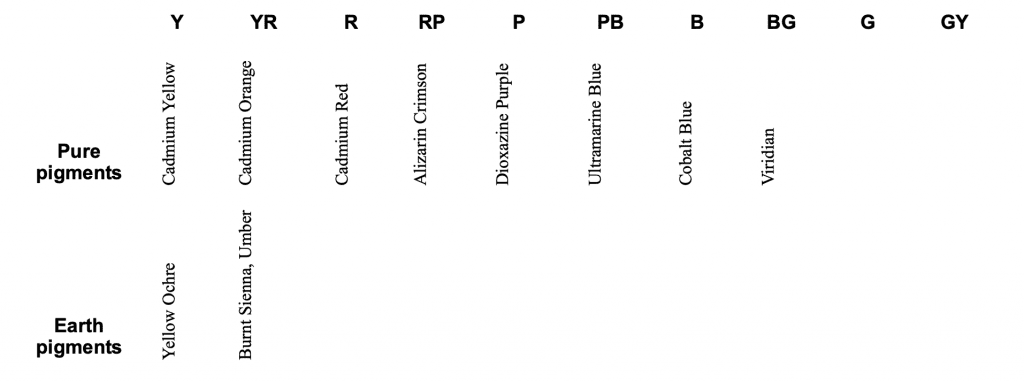
Saturation
Saturation is the degree of richness, purity, or grayness, of a color. For example, cadmium orange is a highly saturated color and burnt sienna is a color with a low saturation. Both colors are the same hue (orange). Similarly, yellow ochre is less saturated than cadmium yellow. A given hue reaches its highest saturation at different values. Neutrals are basically black, white and the greys
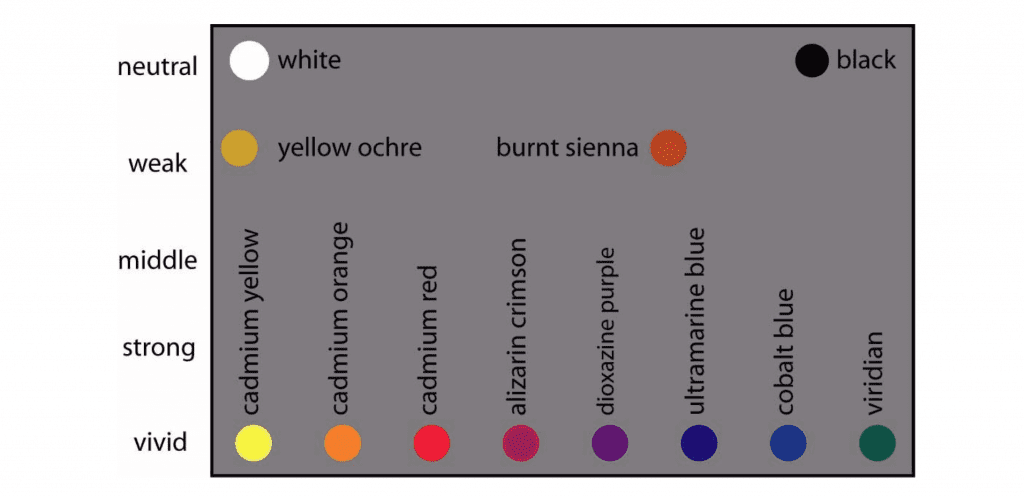
Value
Note: hue is also a term used to describe a particular paint that has been manufactured from a combination of pigments to simulate another more expensive or unavailable pigment, or to create a mix that is more convenient to use than using its component pigments.
Value is how light or dark a color is, from white through gray to black. A standard way of describing values is to use the Munsell scale numbers. In the Munsell color system, a value zero is black and a value ten is white.
For the sake of convenience, the Apprentice Program uses the numbers one to refer to black and nine to refer to white, even though technically speaking, in the Munsell scale these numbers would refer to ‘almost black’ and ‘almost white’ respectively.
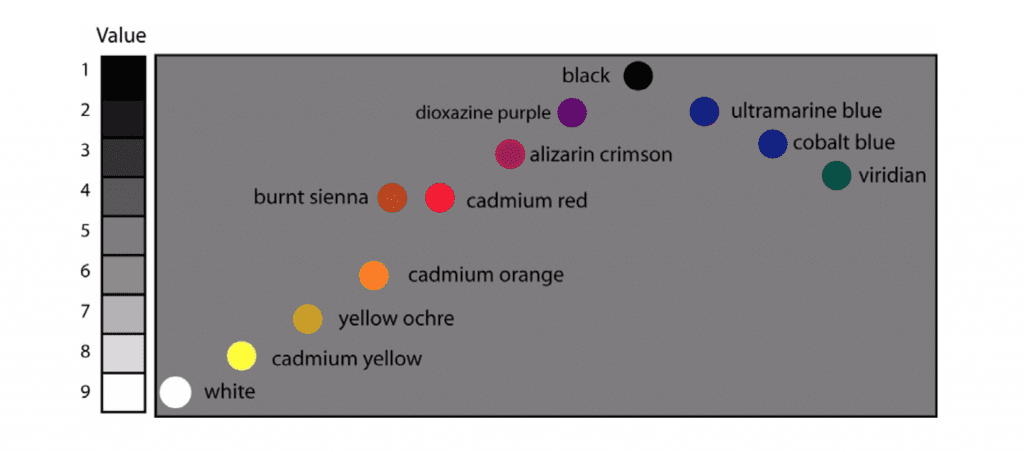
Confusing terms to identify when buying oil paints for beginners
“Hue” tube colors
Some pigments are labeled “hue” by the manufacturer. For example “cadmium red hue”. The term “hue” is used by paint manufacturers to indicate that the color is not really made from cadmium, but has been manufactured from a combination of pigments to have the same ‘hue’ as a cadmium color. When buying paints, look on the label for the list of pigments that have been used to make the color. The reasons for creating the hue can also be to:
- simulate another more expensive pigment.
- simulate a pigment that is no longer available (such as Indian yellow).
- create a mix that is more convenient to use than using its component pigments.
- simulate a pigment that is fugitive (such as Hooker’s Green), and to provide an alternative color that is more lightfast.
Mediums
The term “medium” can also be confusing for beginners. It can either mean:
- A particular method for making a painting or drawing, for example oils, acrylics, pastels, watercolors, photography, digital etc.
- A liquid used to make the paint more fluid so you can apply it more easily, or to create a glaze. Or it could be a liquid to hep your paint dry more quickly. It can also effect the surface look of the paint, whether it appears gloss or matte. In oil paints it is a natural substance such as linseed or poppy oil.
What quality of paints do I need?
Oil paints for beginners can also create confusion about which quality of colors to buy. My suggestion for beginners is to just get the cheapest oil paint you can find to start with and play around with lots of paint on your palette. What you do with it is 50 times more important than the type of paint you use. The more you play the faster you will learn. The more paint you put out on your palette the faster you will learn to develop color harmonies.
It will also be easier for you to develop good brushwork and interesting impasto surfaces. This advice applies if it is brushwork that interests you about paint. If you like refined smooth paint surfaces ignore the suggestions above since you won’t use much paint so price is not so much an issue. I like brushwork and the sensual feeling of a lot of paint, but that is just my personal preference.
If grasped properly, oil paints for beginners are not so difficult.
Oil paints for beginners tips
Follow the rule “fat over lean”. This means that if you are painting one layer of paint on top of another layer of paint, make sure that each successive layer has more oil in it. The reason for this is that layers with more oil in them take longer to dry. If you have a still wet layer under a layer that has dried, the paint surface will crack.
Try to use the same manufacturer of oil paint and medium, as they will work best together.
Suggested palette of 9 oil paints for beginners
Here are some tube colors that are good oil paints for beginners, if you are serious about learning how to paint. These nine paint tubes are all you need for your first set of lessons.
Several large tubes of Titanium White plus small tubes of:
- Cadmium Lemon or Cadmium Yellow Light (cool yellow)
- Cadmium Red Light (warm red)
- Alizarin Crimson (cool red)
- Ultramarine Blue (violet blue)
- Dioxazine Purple (violet)
- Cerulean Blue or Phthalo Blue (green blue, dark)
- Viridian Green (cool green, middle value)
- Black
- Burnt Umber (warm dark brown)
What other colors can I add?
To expand the range of colors you can mix, you can expand the above list of oil paints for beginners to add these pigments:
- A selection of paints that will let you mix all of your high saturation colors. Use the pigments I specify in the GOSP Palette. This will give you maximum flexibility. The brand is not so important as making sure you have the right pigments (learn the difference between paint and pigment). To get the right pigments, look for the Color Index Number of the pigments on the tubes you are thinking of buying.
- Buy a bunch of cheap tubes of grays of different temperatures, and optionally a variety of inexpensive greens. This is for your low saturation colors. Get some blue grays, violet grays, and pink grays. Since they are cheap, you can put out lots of paint on your palette and play around with interesting brushwork effects without feeling you are breaking the bank. You’ll need a lot of grays so its better to buy them premixed to save time and stop you falling into the very common beginner habit of using too many saturated colors everywhere in your paintings.
The alternative to step two is to make them yourself from all the leftover paint from your more expensive pigments in step one. This will take quite a lot of paintings though, and obviously using your expensive pigments to make cheap grays is not the most cost effective way. However I find I make plenty of mud after painting continuously for a few days that after a while I don’t need to use those cheap pre-mixed grays because I end up making my own.
I am sure the above tips would make oil paints for beginners a fun activity.
More blog posts about oil paints:
- Learn about alla prima painting.
- For more advanced palettes and which one to use for different purposes, see our how to choose oil colors tool.
FAQs about oil paints for beginners
Which oil paint colors are best for beginners who want to see if they enjoy painting?
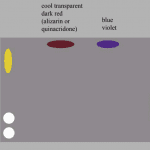
Oil Paints for Beginners – As an absolute beginner who wants to see if painting is for you, without spending a lot on supplies, it is best to keep your palette very simple. This palette only has three tube colors (a red, a blue and a yellow – the three primary colors), plus white. From these three basic colors you can create a great range of color mixes, (greens, purples, and oranges – the three secondary colors) so you can match colors in nature as well as other subjects such as still life objects.
What are the three properties of oil paints I need to understand?
Oil Paints for Beginners – Each color has three special properties which you must understand in order to paint well: hue, saturation and value. If you don’t understand each property, you will never be able to paint what you see in front of you. Hue is what we all think of when we read the word ‘color’, it refers to where the color lies on the light spectrum, such as blue, green, yellow, purple, etc. Saturation is the degree of richness, purity, or grayness, of a color. Orange is a very saturated color, whereas brown is a less saturated version. Value is how light or dark a color is, from white through gray to black. For example you can have blues that range from light to dark.
As a beginner should I start with oil paints or acrylic paints?
Oil Paints for Beginners – This is a common question. The advantage of acrylics always used to be that it was easy to cleanup, since you only need water to clean your brushes. However, you can now buy water-soluble oil paints, so that is no longer the sole advantage of acrylics. The problem with acrylic paints is that they dry very quickly. This means that it is difficult to blend between two shapes. It is also difficult to match colors after they have dried on your canvas because the acrylic paint changes value slightly when it dries. For this reasons it can actually be a little easier to paint with water-soluble oils compared to acrylics. Professional artists generally, but not always, use oil paints because of their versatility. Most master artists of the past and present use oil paints and works in oil are often considered are more appealing to art collectors.
Additional links
- history of oil paints on wikipedia
Thank You
Thank you for taking the time to read this article. I hope you find it useful. If you would like to get free painting tips by email, please sign up for my free tips newsletter.
If you are interested in a structured approach for learning how to paint, take a look at my online painting classes.
Happy painting!
Barry John Raybould
Virtual Art Academy
What The Students Are Saying
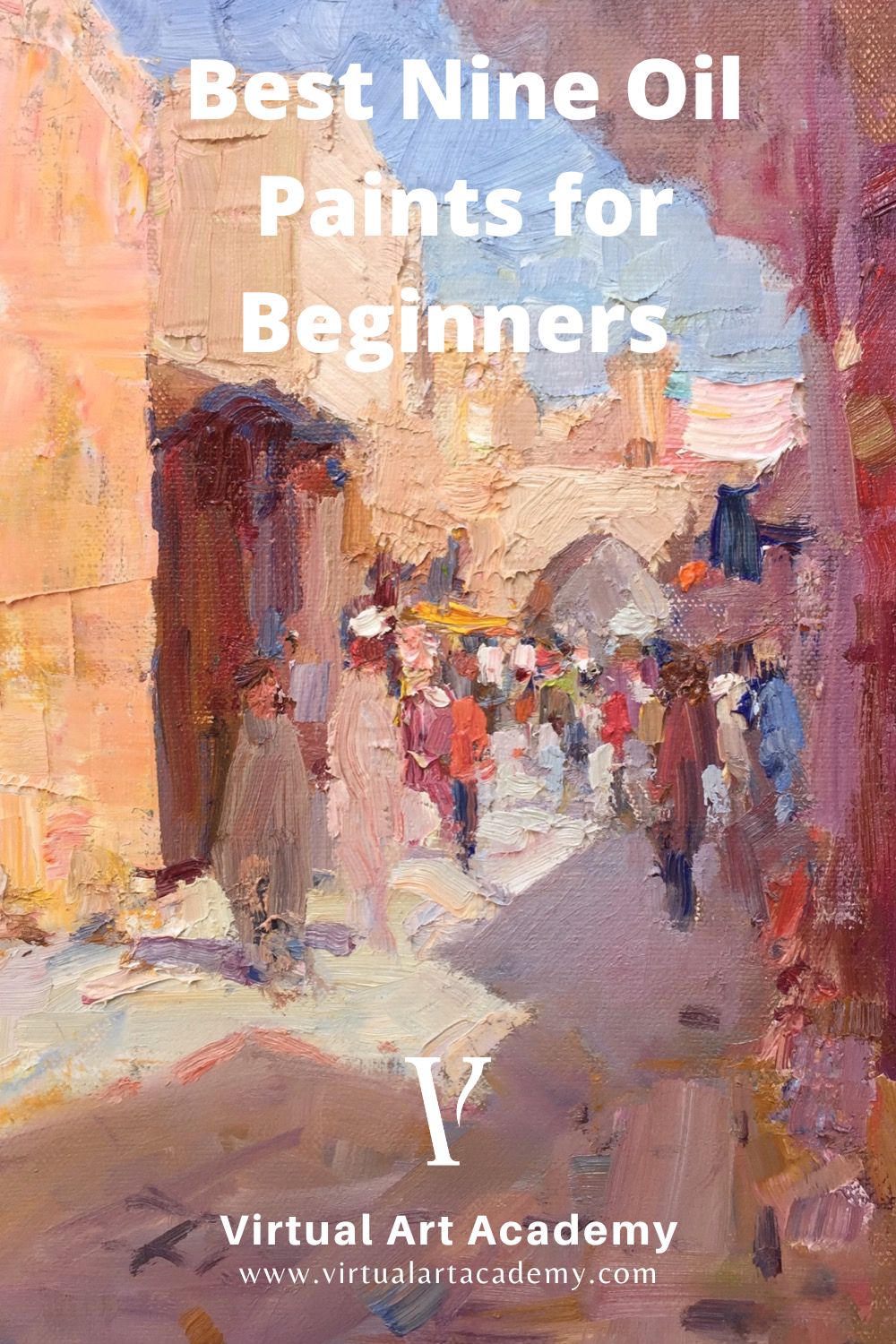
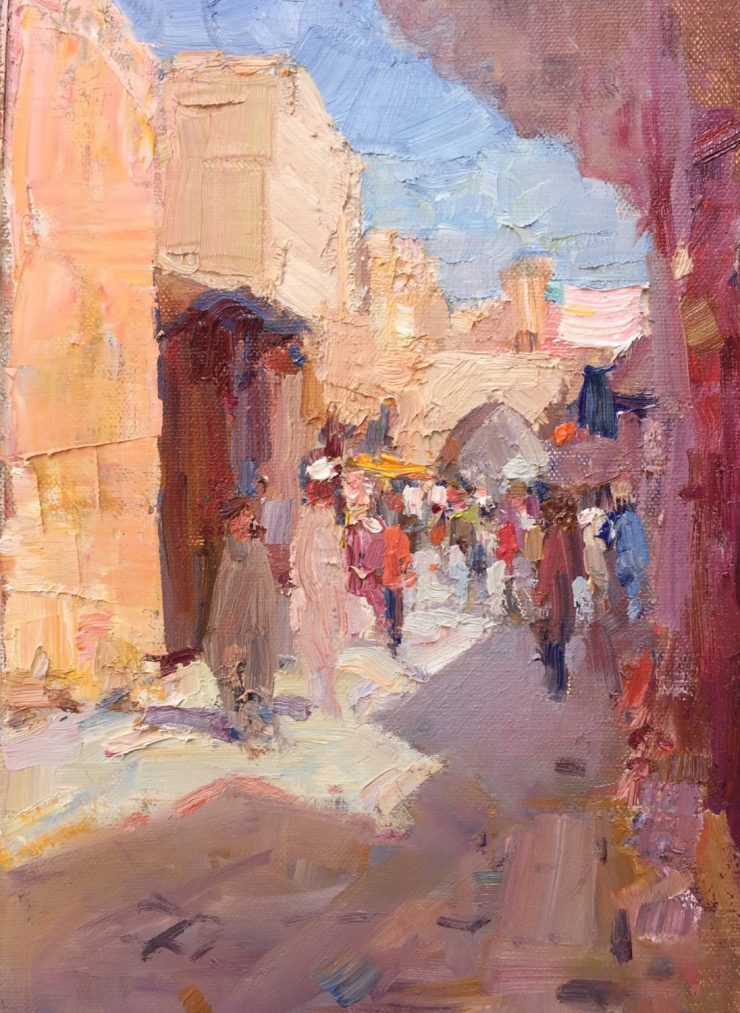









Thank you. I’m looking forward to the info on youtube. I’m very interested in the cool versus warm colours. Many are obvious, but I struggle with the blues…which receed and which blues jump forward? Thank you for helping me to explore this wondrous world of oil painting.
That’s a good question. In a sky, a blue with some red in it, like ultramarine blue, will be seen at the top of the sky. A blue with a yellow in it, such as phthalo blue, will be seen lower down in the sky. So you could say a reddish blue comes forward, and a yellow blue recedes.
Barry
Can you tell me exactly what the names of the three primary colors you suggest to buy if I want to start the simplest way possible? I see alizarin crimson, blue violet, and a yellow in the picture but I don’t see a name for the yellow. Thank you for this article also it’s one of the best I’ve read so far for beginners.
Ultramarine Blue, Cadmium Yellow Light, and Alizarin Crimson are a good starting point.
Best Regards
Barry
Fat over thing or thin over thick is understandable but what if your painting wet on wet style
the rule is thick over thin, or fat (more oil) over lean (less oil). If you are painting wet in wet (alla prima painting), you still follow the same rules. I use a drying medium such as Liquin or a medium consisting of Dammar varnish and turps as my thin coat when painting alla prima, because it dries quickly, and you can then paint thick passages of paint on top of it.
Barry
Thank you very much for the informative information. I’ve never or rarely take information from a book and applied it to my paintings. I’ve had a very hard time through life concentrating on reading instructions or and absorbing them. I try to paint what I see and go from there.
The oil paint I use is winsor & Newton / Winton. I purchased my oils and canvas from (Cheap Joe’s). It’s an online purchase. I have sold one painting in my lifetime for $900. I couldn’t tell you whether it’s worth $25 or $10,000. Is there any way that I could show you what I have painted so you could critique and tell me what you think of them in an honest answer? I’m 73 years old and I know I still have so much to learn. There are two paintings I would love to show you if you would like to see them? How do I do this?
Thank you so much for the time I’m listening to me.
Don Nowak💥
you can send it to Barry via the Contact page on this website